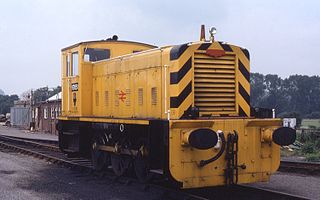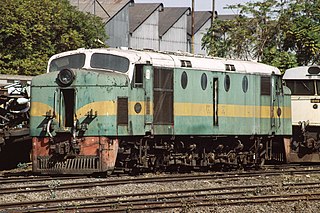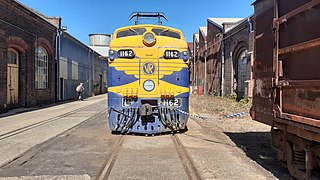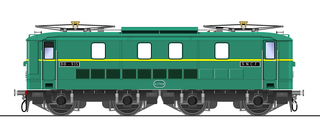Related Research Articles

The British Rail Class 40 is a type of British railway diesel electric locomotive. A total of 200 were built by English Electric between 1958 and 1962. They were numbered D200-D399. They were, for a time, the pride of British Rail's early diesel fleet. However, despite their initial success, by the time the last examples were entering service they were already being replaced on some top-level duties by more powerful locomotives. As they were slowly relegated from express passenger uses, the type found work on secondary passenger and freight services where they worked for many years. The final locomotives ended regular service in 1985. The locomotives were commonly known as "Whistlers" because of the distinctive noise made by their turbochargers.

The British Railways Class 24 diesel locomotives, also known as the Sulzer Type 2, were built from 1958 to 1961. One hundred and fifty-one were built at Derby, Crewe and Darlington, the first twenty of them as part of the British Railways 1955 Modernisation Plan. This class was used as the basis for the development of the Class 25 locomotives.

The British Rail Class 73 is a British electro-diesel locomotive. The type is unusual in that it can operate from the Southern Region's 650/750 V DC third-rail or an on-board diesel engine to allow it to operate on non-electrified routes. This makes it very versatile, although the diesel engine produces less power than is available from the third-rail supply so the locomotives are rarely operated outside of the former Southern Region of British Rail. It is one of the first bi-mode locomotives ever built. Following the withdrawal and scrapping of the more powerful Class 74 bi-mode locomotives in 1977, the Class 73 was unique on the British railway network until the introduction of the Class 88 bi-mode locomotives in 2017. Ten locomotives have been scrapped.
Although prototype diesel locomotives ran in Britain before World War II, the railways of both the Republic and Northern Ireland changed over much more rapidly from steam to diesel traction than those in Britain, due to the island's limited coal reserves and an ageing steam locomotive fleet.

The British Rail Class 37 is a diesel-electric locomotive. Also known as the English Electric Type 3, the class was ordered as part of the British Rail modernisation plan. They were numbered in two series, D6600–D6608 and D6700–D6999.

The British Rail Class 97/6 0-6-0 diesel shunting locomotives were purpose-built for departmental duties by Ruston & Hornsby at Lincoln in 1953 (97650) or 1959 (97651-654). There are minor technical differences between 97650 and the 1959 batch.

The X class is a class of diesel locomotives built by English Electric for the Tasmanian Government Railways between 1950 and 1952. They were the first class of diesel locomotive to enter mainline service on a Government-owned railway in Australia.

Rhodesia Railways class DE2 are a type of diesel locomotive built for operations on Rhodesia Railways in the 1950s. The first entered service on 22 June 1955.

The Y class is a class of diesel locomotives built by the Tasmanian Government Railways between 1961 and 1971.

The NR class are Australian diesel-electric locomotives built by A Goninan & Co for National Rail between 1996 and 1998. They are currently operated by Pacific National. The C44aci model locomotives built by UGL Rail at Broadmeadow adopted the design from the NR Class.

The Victorian Railways L class was a class of electric locomotives built by English Electric and operated by the Victorian Railways and later V/Line from 1953 until 1987 primarily on the Gippsland line. They were the only class of main line electric locomotive operated in Victoria.

The T class are a class of diesel locomotives built by Clyde Engineering, Granville for the Victorian Railways between 1955 and 1968.

The South African Railways Class 5E, Series 1 of 1955 was an electric locomotive.

The R Class are diesel locomotives built by English Electric, Rocklea for the Western Australian Government Railways in 1968. They were followed by the revised RA class.

The D/DA class are a class of diesel locomotives built by Clyde Engineering, Granville for the Western Australian Government Railways in 1971-1972.

The 2350 class were a class of diesel locomotive built by English Electric, Rocklea, for Queensland Railways in 1973–1974. All were later sold to AN Tasrail.

The Za class are a class of diesel locomotives built by English Electric Rocklea for the Tasmanian Government Railways in 1973.

The Tasmanian Government Railways V class are a class of diesel locomotives operated by the Tasmanian Government Railways.
The RA Class are diesel locomotives built by English Electric, Rocklea for the Western Australian Government Railways between 1969 and 1972. They were a revised version of the R class.

The SNCF Class BB 900 was a class of 35 mixed-traffic electric locomotives built between 1936 and 1937 for État. The class was a development of the pre-war Midi Class E4700 and very similar to the later Class BB 300 and Class BB 325. Initial use was on the Paris–Le Mans line. The class was withdrawn in 1987 after 50 years in service.